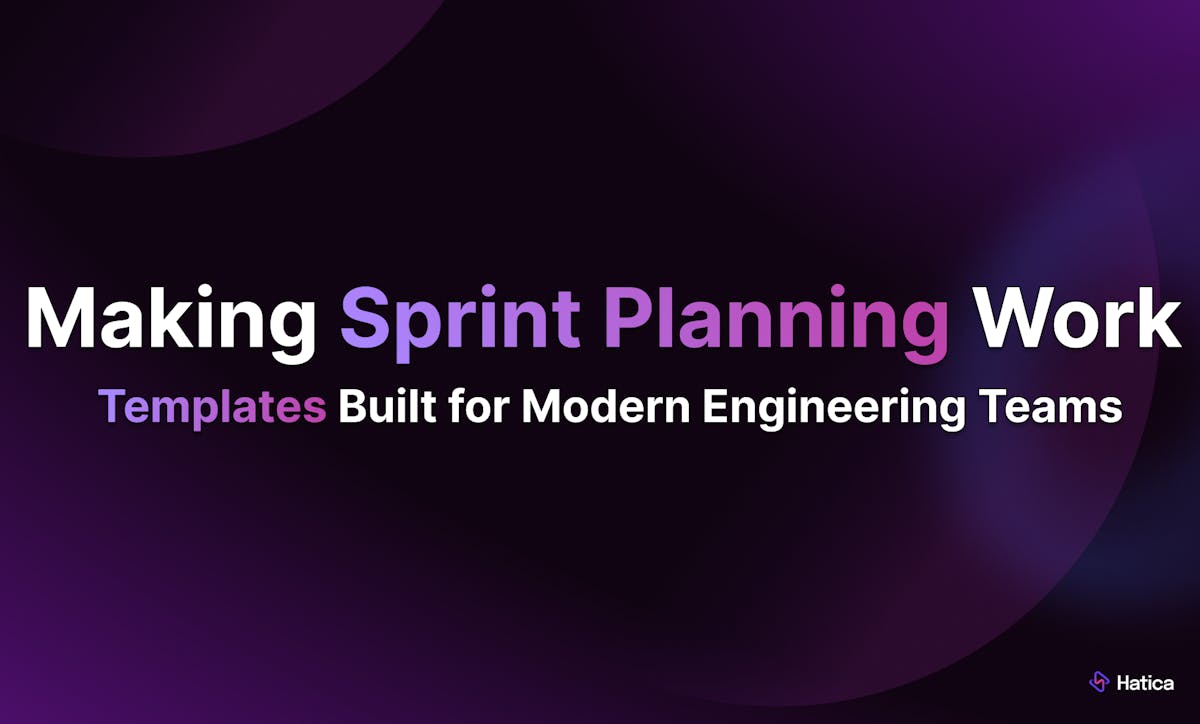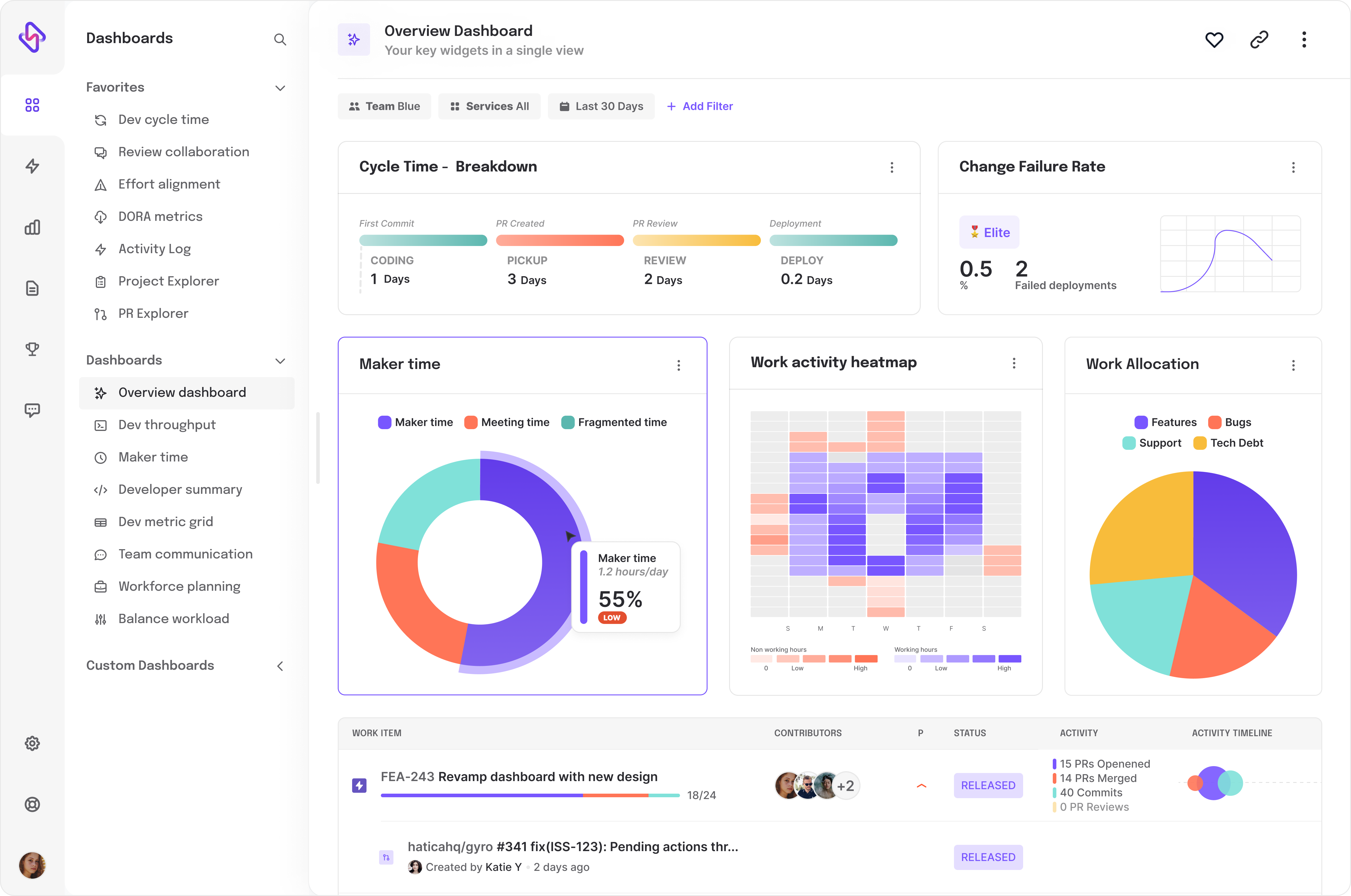Your engineering team’s momentum hinges on how well your sprints are planned.
Sprint planning has always been one of the trickiest parts—not because it’s complicated, but because it’s so easy to get wrong. On the surface, it seems simple: set some goals, assign tasks, and get to work. But in reality, small missteps in planning can quickly snowball into something bigger and ripple throughout the sprint.
Sprints are the heart of Agile, but they only work when everyone’s clear on what needs to be done and why it matters.
That’s where a good sprint planning template comes in—it helps you structure the conversation, align expectations, and more.
In this blog, I’ll walk you through how I’ve refined our sprint planning process over time, the template I rely on to keep things organized, and the aspects that have reshaped the way I approach planning.
So let’s get into it!
What Are Sprint Planning Templates and Why Are They Important?
If you’ve ever walked out of a sprint planning meeting feeling like you didn’t quite cover everything—or worse, that everyone has a slightly different idea of what the sprint is actually about—you’ll understand why a sprint planning template is so important. It’s not a checklist but a structure that keeps everyone aligned, focused, and clear on what success looks like.
Think of it as a blueprint for your sprint. Without one, it’s easy for conversations to veer off course, for goals to stay vague, or for important discussions to be left until it’s too late. A template ensures that nothing critical gets missed and that everyone leaves the meeting with the same understanding of what needs to be done and why.
Why Templates Alone Aren’t Enough
When I first started using sprint planning templates, they felt like a silver bullet. They provided structure, kept discussions focused, and ensured nothing was missed.
But what I’ve realized over time is this: templates are tools, not solutions.
The real value of a template lies in how well it adapts to the dynamics of your engineering team. For instance, a template that doesn’t account for recurring blockers or underutilized capacity isn’t just incomplete—it might be counterproductive. That’s a lesson I learned the hard way after seeing “perfect” plans fall apart mid-sprint because they didn’t account for the inevitable surprises.
What Goes Into My Sprint Planning Template
Over the years, I’ve refined my sprint planning template to focus on a few key areas. That said, sprint planning is not a one-size-fits-all process. Each engineering team has its own dynamics, challenges, and priorities, so what works for me might need tweaking to fit your team’s unique needs.
That said, here are the elements I’ve found most effective:
1. Sprint Goals That Tell a Story
Every sprint starts with a clear purpose. For example, instead of just saying, “Fix critical bug Y,” I frame it as, “Resolve bug Y to stabilize Feature Z for the next release.” This approach gives the team clarity on how their work fits into the bigger picture and helps them understand the why behind each task.
2. Capacity Planning That’s Realistic
Early on, I used to plan for 100% of the team’s availability, but it rarely worked out. Now, I plan for about 85% capacity, leaving room for blockers or ad hoc tasks. This small change has drastically reduced stress and improved our focus on planned work. Of course, the ideal capacity buffer can vary depending on your engineering team’s workflow—some might need more, others less.
3. Prioritization That’s Honest
Not all “medium-priority” tasks are as harmless as they sound. I’ve noticed that these tasks can sneakily eat into bandwidth meant for high-priority work. As a result, I now spend more time reassessing priorities to ensure we’re working on what matters most. For other teams, this might mean reshuffling tasks during the sprint or taking a closer look at backlog grooming practices.
4. Blockers Built Into the Plan
Blockers used to be quite a challenge until I made them a part of the process. Now, before every sprint, I sit down with the engineering team to identify potential blockers. If they’re significant, we defer related tasks to the next sprint rather than setting ourselves up for failure.
Some engineering teams may prefer to tackle blockers as they arise, but for us, looking at previous sprint data and planning them for the next sprint has been really helpful.
What Are the Benefits of a Sprint Planning Template?
Everything in One Place
With a digital template, I don’t have to hunt for notes in five different places. It’s all there—tasks, priorities, blockers, and metrics. And the best part? The team can access it anytime. If someone needs a quick check-in on sprint goals, they know exactly where to look.
Real-Time Updates
Plans change. Blockers pop up. Priorities shift. With a digital template, I can adjust things on the fly, and the whole team sees it instantly. It’s saved us from so many mid-sprint miscommunications and makes everything feel a lot more coordinated.
Data at Your Fingertips
The real game-changer for me has been how easily a digital template integrates with analytics. For example, we pull in metrics like planning accuracy and capacity from Hatica. It helps us avoid overcommitting and plan around what we know the team can realistically deliver.
Better Collaboration
Sprint planning isn’t something I do alone—it’s a team effort. With a digital template, everyone can jump in, leave comments, or tweak something if they spot an issue. It feels like we’re building the plan together rather than following something rigid.
A Clear History
Looking back on previous sprints has become so much easier. If something didn’t go as planned, I can pull up the old template and see exactly where things started to go sideways. It’s been invaluable for learning and improving without having to guess what went wrong.
Customized to How We Work
What I love is how customizable these templates are. We’ve tweaked ours to match how our team likes to work—whether it’s syncing with Jira, highlighting blockers, or adding sections for retrospective notes. It’s not just a template; it’s our template.
💡Suggested Reading: Balancing Sprint Reviews and Sprint Retrospectives: The Dual Engines of Engineering Success
How Can You Use Hatica to Plan Your Sprints?
👉How I Plan My Sprints? Check out this video
Sprint planning is one of those things that seems simple on the surface—set some goals, assign tasks, and move on. But in reality, it’s never that straightforward. Plans fall apart when blockers pop up, priorities shift, or you realize halfway through the sprint that you’ve overcommitted. That’s where Hatica has made a real difference for me. It gives me the data I need to make smarter decisions upfront.
Here’s how I use it:
1. Start with the Metrics That Matter
Before I start planning, I always check Hatica’s project dashboard. It’s become my go-to for understanding how the last sprint went. Metrics like planning accuracy and capacity utilization tell me if we’re biting off more than we can chew—or if we’re leaving room for surprises. For example, if I see our planning accuracy has been below 50%, it’s a clear sign we need to adjust expectations for the next sprint.
2. Plan for the Blockers You Already Know About
One thing I’ve learned is that blockers aren’t really surprises—they’re just things we didn’t plan for. Hatica helps me spot patterns, like recurring delays caused by external dependencies or ad hoc tasks that always sneak in. Now, I include those in the plan upfront. It’s not about fixing everything—it’s about being honest about what might slow us down.
👉 How do I use Hatica to plan my Sprints? Check out this video.
3. Rethink What’s Actually a Priority
It’s easy to get caught up in “medium-priority” tasks that feel important but don’t really move the needle. Hatica has shown me how much time we’ve been spending on these tasks compared to high-priority ones. It’s been an eye-opener. Now, I’m much stricter about what makes it into the sprint. If it doesn’t directly align with our goals, it’s out.
4. Bring the Team into the Plan
One of my favorite things about Hatica is how it makes sprint planning feel collaborative. Instead of just presenting a plan, I share the metrics with the team. We discuss what worked, what didn’t, and what we should adjust. It’s no longer about me deciding what’s best—it’s about us figuring it out together.
Recommended Apps for Sprint Planning
I’ve found that sprint planning isn’t just about one tool—it’s about how your tools work together to make the process seamless. Here’s what I use and how they’ve helped:
Jira
If you’re working with a software team, Jira is probably already in your stack. I love using JIRA for handling backlogs, project management and tracking sprint velocity. I like how it syncs with Hatica to give me a clearer picture of what’s working and what’s not. Together, they make tweaking priorities mid-sprint a lot easier.
Slack
Communication during sprint planning is crucial, and Slack is a lifesaver for quick discussions. We’ve set up Hatica integrations in our team channels to surface insights—like task completion rates or blockers—right where we’re already talking. It saves so much time and keeps everyone in the loop.
Confluence
For documenting plans and retrospectives, Confluence has been a lifesaver. It’s where we keep everything—our sprint goals, outcomes, and lessons learned. By pulling in metrics from Hatica, we make these records more actionable and future-proof.
What Sprint Planning with Hatica Has Changed for Me
Hatica has made sprint planning less about gut instinct and more about clarity. It helps me cut through the noise, focus on what matters, and build a plan any engineering team can actually stick to and deliver with confidence.
What’s changed for me is how I approach the process now. I no longer feel the pressure to plan the “perfect” sprint. Instead, I focus on building a plan a team can stick to—one that’s flexible enough to adapt when things inevitably change.
Now I can expect sprints that feel more grounded, less stressful, and more focused on outcomes rather than just ticking boxes. It’s no longer about just getting through the sprint—it’s about making every sprint count towards a bigger goal.



